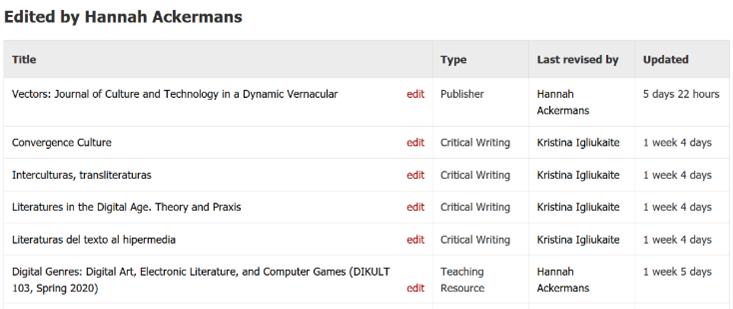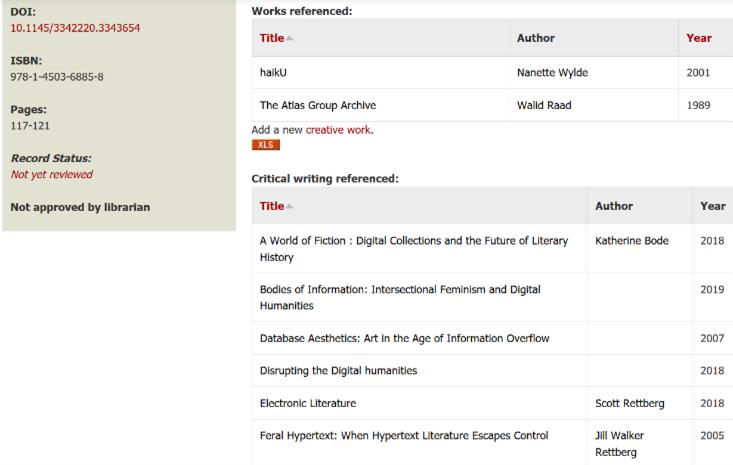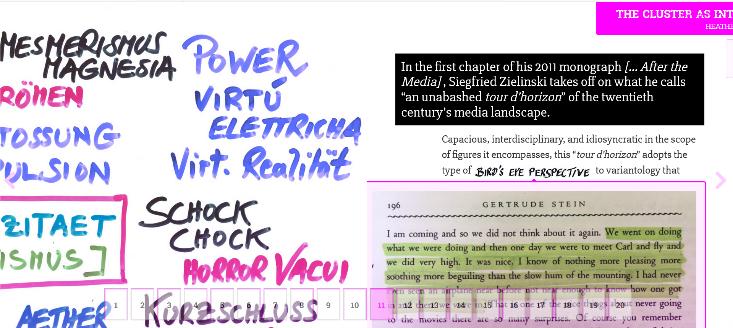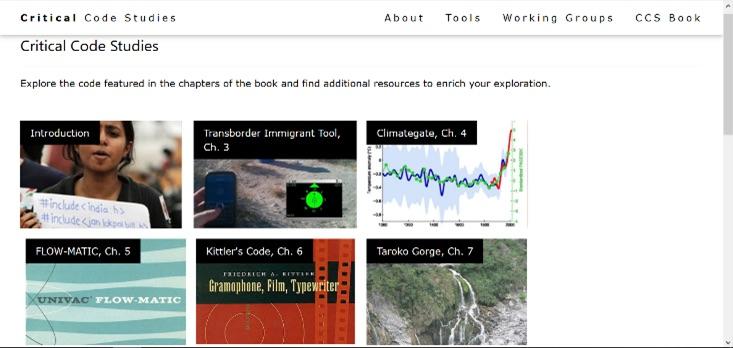
Born-Digital Publications: Public Databases, Hypertext Journals, and Companion Websites as Digital Humanities Tools
Although we tend to think about digital humanities as the application of quantitative methods to digitized material, other digital tools can impact scholarship considerably. I introduce three types of born-digital publications: public databases, hypertext journals, and companion websites. I argue that these are digital humanities tools that drive nonlinear research practices, enabling personal and communal readings.
Born-Digital Publications
Following the increasing hypertext practice in digital culture over the past decades, reinventing the medial mode of academic publication becomes desirable to open up new research practices and knowledge production. Of course, academics do already take matters into their own hands in their digital presence. There are some academic rock stars such as Miriam Posner, whose individual blog posts with reflections on the digital humanities are frequently cited in academic publications. In general, social platforms are predominantly used for conversations, self-presentation, and networking. But how are academic publication platforms taking shape in born-digital formats?
Although we tend to think about digital humanities as the application of quantitative methods to digitized material, other digital tools can impact scholarship considerably. The bulk of academic production consists of print publications and online linear texts, but new platforms are taking practice-based steps towards multimodal “born-digital” publications. I use the term “born-digital” here specifically for academic dissemination in which the digital form has extensive influence on the content and shape of the research practices.
As such, I regard the creation and maintenance of such platforms as well as the writing process as digital humanities scholarship. Here, I introduce three genres of open-access publication, namely public databases, hypertext journals, and companion websites. Although three very different genres, they are tied together by their use of hypertext as alternative to linear argumentative articles. I address the media-specific strengths of these platforms in relation to their potential negative effects within current academic and cultural structures to further develop born-digital academic publications as a generative and inclusive practice.
The Ontological Influence of Public Databases
Building public databases might be the first thing people think of in relation to digital humanities across disciplines. New fields even develop and grow around the infrastructures of these databases, especially if the database documents ephemeral media texts with little pre-existing infrastructure. The field of electronic literature particularly flourishes in databases of creative works. Each database has a specific approach or corpus. While NT2 Répertoire focuses on taxonomies for types of interactivity, for example, the Electronic Literature Directory chooses longer descriptive entries. Several databases are language-based, such as the Archive of German Electronic Literature and the Spanish-language database Ciberia. Electronic literature databases are usually built and funded initially within the context of a research project, making the database a born-digital publication of the project team’s research. Here, I use the ELMCIP Knowledge Base (KB) as a case study to demonstrate how crowd-sourced production and cross-referencing represent ontological and ideological arguments in the database.
Although the original research project was concluded in 2013, the KB has grown into a leading database in the field. With over 13,000 entries, it documents creative works, critical writings, events, and more. An unfeasible task for just one research team, so the KB asks unaffiliated contributors to record and update information. The KB’s content, then, is inextricably linked to the electronic literature community. And the KB design reflects this practice. Contributors’ dashboards have two tables: one that shows all the records this contributor has created and the other all the records they have edited. Rather than showing only your own activity however, the order is determined by the last edits by any user. My dashboard (figure 1), for example, shows some records that I edited years ago, but they appear at the top of my dashboard because other contributors have developed those records further. The columns show who revised the records and how recently. In addition to the dashboard, each individual record also names who created the record and the revision history shows who worked on the record afterwards. These design choices, then, reflect the KB’s methods for its born-digital publication of the database.

Figure 1- Partial screenshot of KB’s dashboard view, showing a table titled “Edited by Hannah Ackermans”, with columns “title”, “type”, “last revised by” and “updated”.
We can also see this value of community in the structure of the records themselves. The KB cross-references records to present the network of texts and practices that are central to the field of electronic literature. Figure 2 shows part of the KB record of my paper for the ACM Hypertext 2019 conference. The two tables titled “works referenced” and “critical writings referenced” show the primary and secondary sources that I cited in that paper. The database is a hypertext that links to the records of all these works. When I click on “Database Aesthetics”, for example, I can see the metadata and description of this book and see that I am hardly the first person to cite this source, considering the long table of “Critical writing that references this”. This hyperlinked structure of the KB represents an ontology of electronic literature not as separate entities, but as a network of texts.

Figure 2 Partial screenshot of critical writing record showing two tables, respectively titled “works referenced” and “critical writing referenced”, with columns “title”, “author”, and “year”.
Both the internal structure of the KB and the representation of documentation practices, then, are a demonstration of the argument that community is foundational to the development of electronic literature. The different content types in the KB represent the network of texts, people, events and other resources that together represent the community. Public databases are not a neutral resource but the result of research and choices that contain ontological arguments of the documented subjects though the scope and metadata. This demonstration of critical reflection about the field is, however, not generally regarded as an academic publication. This neglect has far-reaching consequences. Databases are a driving force in the field, as it collects otherwise distributed and ephemeral objects to build a community aware of its history (Walker Rettberg 2015).
As a result, the approaches of the databases influence how a field develops. We must therefore evaluate public databases within the context of open access born-digital scholarship (Burdick 2012). Within this context, I propose database criticism to develop a set of values for public databases that highlight all the elements that we wish to be part of the field going forward (Ackermans 2020). This criticism, then, is not a way to tear down each other’s work, but rather what Kathleen Fitzpatrick (2019) calls “generous thinking”, in which critique is meant to build rather than disrupt. Public databases are digital humanities publications that are shaped by their dissemination format as well as shape further research in the field.
Making Associations in Hypertext Journals
Nonlinearity and multimediality are pillars in electronic literature, which has used hypertext as a main mode of storytelling and distribution in electronic literature. There have been intermittent experiments with hypertext scholarly journals. Between 1999 and 2001, frAme published multimedial scholarship and art. Later, Vectors (2005-2013) gained reputation as a scholarly hypertext journal. Additionally, platforms such as SCALAR are specifically developed for humanities scholars to publish in multimedial/hypertextual formats. In a wide definition of hypertext journals, the term can simply refer to online journals. Here, I am using hypertext journals in a narrow understanding of publications that use hypertext to affect the argumentative structure of the articles. Let’s take a closer look at the second issue of thresholds, to explore how the hypertext and multimedia allow for associative arguments.

Figure 3 Screenshot of split screen design of thresholds showing half of a photograph on the left and an article on the right
thresholds has a particular navigation to create a hypertext characterized by a split screen design, which generally has text on one side and other media on the other. The split screen opens up the potential for new connotations and connections through multiple combinations while you ‘leaf’ through the issue. At the same time, the half title at the top (see figure 3) does not let you forget that whatever association this combination of image and text entices, this is your own connotation and connection. This begs the question of how the reader’s agency and the text structure overlap and foreground each other.
Issue 2, called TRACES, introduces the functioning of the journal as a digital text most explicitly. The articles are introduced in associative order, instead of their linear numbered order. This testifies to the editors’ nonlinear expectations in this particular issue, while also implicitly acknowledging that scholars do not usually read journals linearly cover to cover. After explaining the issue’s use of multimedia and hypertext, the editors point out that “of course, you might choose to bypass these carefully designed features altogether to examine TRACES as a complex media object. View the site as source code in your browser and a different topography becomes visible”. Or, if you actually did read it in the source code: “Of course, you might choose to bypass these carefully designed features altogether to examine <imgsrc=\"\/css\/images\/ clear.gif\" data-lazyload=\"true\" data-original=\"\/images\/5a8ca645ee70e_attachment.jpg\" style=\"width: 150 px;height:auto;\"> as a complex media object. View the site as source code in your browser, and a different topography becomes visible”. Instead of the text TRACES, this word appears as an image in stylized capital letters. Although this reads as a typography, the source code makes explicit that this is actually an image. These and other multimodal elements are used throughout the issue, creating a communal style among the authors of the work.
The individual contributions make associative arguments. Heather Love’s article “The Cluster as Interpretive Gesture”, for example, contains hyperlinks in ‘handwritten’ typography. Clicking on the image “HOVER”, handwritten in black marker, for example, reveals a text fragment from Ezra Pound’s The ABC of Reading about exhibits, stating that “the ideal way to present the next section of this booklet would be to give the quotations WITHOUT any comment whatever [sic]”, only to immediately lament the impossibility of this option as “in the imperfect state of the world, one MUST tell the reader”. An interesting choice, considering that the whole issue consists of comments on quotations from Zielinski’s work. Love does not explain the Pound quotation in her article, yet this text fragment reflects the varying levels of comments on medial mode of the issue. The texts explain some uses of hypertext and multimedia, while others remain open. The introduction, for example, refers to the issue as topography and lines, but does not explicitly refer to the maps on the background and illustrations of single routes, except to attribute them to their source. This is, in Pound’s words, “a plan […] the readers would see”. Reading this type of multimodal publication raises different expectations from the academic text than conventional articles do, encouraging more associative connections for both the author’s production and the reader's interpretation.
Innovative digital publications are not without challenges when it comes to accessibility. thresholds’ editors explain that they are committed to accessibility, but that the website will not display properly on every browser or device. Indeed, the beautifully designed pages might show only partially or even overlapping on smaller screens. Additionally, multimedial articles can also be challenging to access with the assistive technology of screen readers, as some words are images such as the citations above. Finally, the experimental nature of the work can make it less understandable to users who have not been exposed to similar forms of argument before. Hypertext journals have a lot of potential for making media-specific arguments, but each publication format has different affordances that need to be interrogated to create an accessible reading experience.
Contextual Reading through Companion Websites
Companion websites, that accompany print publications of various sorts, might seem like the least exciting example of the three born-digital publications discussed. Rather than a radical way to present research in the shape of a public database or multimedial hypertext, the companion website, by its very title, is an addition to the print book. Yet the website can accompany the print publication in various innovative ways that act as intellectual interventions. The term covers a broad range of genres, referring to websites of newspapers, magazines, and books, including fiction, scholarly monographs and edited collections, or student textbooks. Over the past decades, main publishers such as Sage and MIT Press as well as individual authors have increasingly made companion websites for academic publications. Some companion websites are best described as paratext whereas others are publications themselves. I analyze the brand-new companion website to Mark Marino’s Critical Code Studies (2020) as a case study to demonstrate the shaping effect of a companion website in readership and community, especially when the book has a born-digital subject.

Figure 4 Screenshot of the overview page to the different pieces of codes that Marino analyzes in Critical Code Studies.
In Critical Code Studies, Marino sets out to persuade people of the significance of source code within cultural analysis. Through a variety of different genres of code, Marino demonstrates the creativities and ambiguities present in source code, practicing what he names critical code studies (CCS). Although companion websites exist across disciplines, Marino’s born-digital subject adds an extra urgency to the development of a companion site. All the code discussed in the book is available on the companion website for people to read, investigate and tinker with. As embedded views from Github, individual lines of code are easy to find and the code can be copy-pasted into an editor to explore and adapt further. The different pieces of code are categorized by book chapter to be easily findable for readers of the book.
The contextual sources used in the analyses of the book are also provided in chapter webpage through hyperlinks to external content along with metadata about the code. In combination with reading the book, the companion website provides all the necessary content for readers to explore the code and context and develop a critical mindset towards code. One might wonder why this is a print book at all, rather than an elaborate digital publication, yet reading a print book does provide a set of conventions and values that invite people to read with a particular focus. The print book validates the field in current academic structures and the combination of reading the print book beside the companion website without having to toggle between windows works very well. This combination makes for a good infrastructure to invite people into the field.
Companion websites provide access to long-form references and contextual sources. Readers are then invited to take on a more active role in interpreting source code as well as participating in working groups.
The companion website is important in relation to the book but also beyond that. Marino set up the website as a platform for a community of people interested in analyzing code. In this sense, the website functions in a similar way to public databases that both show the scope of the field and build this field further on the platform. The website hyperlinks to the biennial online working groups of CCS that Marino organizes with Jeremy Douglass. Readers of the book and companion site who are new to the field can see all the different exercises and conversations of past participants of the working groups. This puts into practice what Marino argues in the book: CCS is a field for amateurs and professionals of many different fields, as long as they are interested in the cultural reading of source code. This open social approach sets up the site as a conversation about code, highlighting the layers and ambiguity of any piece of code.
Rather than a one-time publication, the CCS companion website is an ongoing project that Marino plans to keep updating as time goes on. Updatability is a major strength of the companion website compared to the print publication. Some companion websites are hosted by the publishers whereas others are stand-alone websites, which gives authors more freedom to develop the content further. The other side of coin is the labor involved in doing so. It depends on the position of the author whether it is feasible to spend time creating and updating the companion website. Doing this ‘free labor’ (Terranova 2012) is at once expected and denied official value. Companion websites, then, can have various roles in shaping a book project, in terms of content and readership as well as timeline of engagement that is expected from the author.
Now What?
I have argued that born-digital publications make media-specific arguments that interrogate research subjects in different ontological, associative, and contextual ways than linear argumentative articles. This suggests that the publication formats themselves are DH tools that drive nonlinear research practices, which enable singular and communal readings. Public databases give shape to ontological research in database format, both by decisions on what works to include in the database and which metadata gives the best representation of the research subject. Readers browse, read, and even contribute to these databases, which means that they are shaped by the database’s implicit arguments about the research subject. Hypertext journals provide authors with formats to present arguments through multimedia and association, highlighting the nonlinearity of research. Readers in turn read non-linearly by choosing not only which articles to read, but also by interpreting the hypertextual elements within and between the texts. Companion websites provide access to long-form references and contextual sources. Readers are then invited to take on a more active role in interpreting source code as well as participating in working groups. All three types orient themselves towards community, whether a community of contributors in the public database, of authors such as the hypertext journal, or of readers on the companion website.
These new forms of publication come with specific issues to be resolved going forward. Developing standards, ensuring accessibility, and navigating labor are interrelated issues that surface to more or lesser extent in all genres. These issues are not only academic problems but also representative of problems in digital culture at large. Structure and built are valued higher than content and maintenance, a problematic judgment heightened by the fact that maintenance and content creation is predominantly done by minority groups (see Terranova 2012). This links to the academic and professional culture in which people are expected to keep their social platforms, whether Twitter, LinkedIn, or ResearchGate, up to date, which often constitutes labor in people’s personal time. Finally, online content places expectations on readership in terms of available and acquired technology, abilities, and skills. These expectations potentially exclude disabled people, people without access to state-of-the-art technologies and people who are inexperienced with analyzing artistic and multimedia platforms. As such, born-digital publications in academia risk replicating problematic aspects of digital culture.
To develop these platforms further, we need to take into account these issues in the academic setting as well as the reflection that they are in digital culture at large. We need to address how to develop new standards to ensure high-quality production, guarantee accessibility, and account for new forms of labor in academia. Developing the present and future of academia depends on thoughtful ongoing interrogations of these questions. Born-digital publication platforms drive research practices that have the opportunity and power to advance the field. This open access scholarship uses the affordances of the digital platforms to provide a panoramic view of the fields they represent. The potential to create space for underrepresented perspectives through diverse documentation and contextual research build creative and academic communities. As such, the new practices that arise within and from these platforms need to be recognized and valued within digital humanities and academic contexts.
References
Ackermans, H. "Appealing to Your Better Judgement: A Call for Database Criticism". electronic book review (2020).
Burdick, A., Drucker, J., Lunenfeld, P., Presner, T. and Schnapp, J. Digital_Humanities. MIT Press, 2012.
Fitzpatrick, K. Generous Thinking: A Radical Approach to Saving the University. John Hopkins U Press, 2019.
Love, H. "The Cluster as Interpretive Gesture". thresholds, 2, n.p.
Marino, M. C. Critical Code Studies. MIT Press, 2020.
Marino, M. C. Critical Code Studies (companion website). 2020.
McDonald, F. and Trettien, W. "About". thresholds.
McDonald, F. and Trettien, W. TRACES: "Introduction". thresholds, 2 , n.p.
Rettberg, Jill Walker. "Electronic Literature Seen from a Distance. The Beginnings of a Field." Electronic Literature Communities. West Virginia University Press, 2015.
Terranova, T. "Free Labor". Digital labor: The Internet as playground and factory (2012): 41-65.